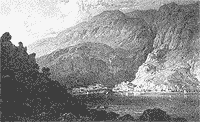

|
Sights - Chania County |
|
|
Robert Pashley's description of the walk |
| ... Soon after this our course changed to the south-west, and we began to approach nearer to the shore. At a quarter past five, Sélino-kastéli (Palaiochora) became visible. The paths which we followed were over rugged rocks, and none of them, I should think, had ever received any labour from the hand of man. Here my horse, though very sure-footed, fell, and made two unsuccessful attempts to rise, each of them followed by a fresh fall, before he recovered himself. On dismounting, to see what hurts he had received, I was surprised to find that they consisted only in some flesh wounds, which bled considerably, inflicted by sharp edges of the rock, on two of his legs. |
|
||
| Drawing from Pashley's book: | |||
| Loutro
|
|||
| The only animal which
one can ride with pleasure in these regions is a mule. The mere size of a
horse's hoof makes it a difficult matter for him to pick his steps in many
places; and the very art of picking his steps is but little known to any
horse, while every mule is a proficient in it.
|
|||
| Soon after my horse's roll, and my sufficiently narrow escape from what would have been, at least, a very disagreeable fall, we arrived at the summit of a precipice, the zigzag descent down the face of which is so steep, rocky, and dangerous, that I was greatly disposed to send Maniás back with my horse, and to proceed with his mule. It was now, however, late; and, since I might perhaps be benighted before reaching Haghía Ruméli, and was also totally unacquainted with the wild region before me, I determined to attempt to get down with the two steeds. This zigzag road winds along the face of a rocky and almost perpendicular precipice of very considerable elevation. Had my horse missed his footing at any one of the turns of the zigzag path, it must have been his last trip. After getting down this steep and difficult descent in safety, we were still at a great elevation above the level of the sea. Although the side of the mountain now slopes off at a much smaller angle of inclination to the horizon, yet it is still so steep that the path continues to be of the zigzag kind nearly all the way down: the face of the mountain here presents a loose surface of stones and a little soil, along which we continued to wind to and fro for about an hour and a half. |
|
||
| Drawing from Pashley's book: | |||
| Captain
Manias
|
|||
| At length we arrived
near the sea-shore, somewhat to the west of the commencement of our
descent over the precipice; and going nearly due west for above a mile, we
reached the little chapel of Hághio Pávlo. Close by it a most plenteous
spring of fresh water rushes out of the beach, and, forming a rapid
streamlet , flows for a few paces before it loses itself in the sea. The
Florentine traveller in Crete, Buondelmonti, whom I have so often referred
to, speaks of this streamlet as being half the size of his own Arno: a
most extravagant exaggeration, as every one must admit who visits St
Paul's spring. ...
|
|||
| St Paul is said to
have conferred other and even still greater blessings than these springs
on the Cretan people, when he visited them after his two years residence
at Rome: he freed their island from all wild beasts and noxious animals.
Unfortunately for the Christian legend, we find that Crete was just as
much commended in ancient times as it is by its present inhabitants, on
account of its freedom from all such animals. The pious heathen used to
ascribe this blessing to the beneficent exertions of Heracles: as the
Christian attributes it to St Paul. ...
|
|||
| On leaving the spring and chapel of St Paul, about seven o'clock, we follow the shore, but the shades of evening spread around us, and I see but indistinctly the grand features of the scenery by which we are surrounded. At twenty minutes before eight, we reach the entrance of the valley of Haghía Ruméli, and Samaría. The bold hanging mountains on each side of the glen, and the noise of its river as it rolls along its rocky bed, make me impatient to see, in broad daylight, what I suppose must be the grandest and at the same time the most picturesque spot in the island. A mile's ride up the glen brings us to the village of Haghía Ruméli. Notwithstanding the lateness of the hour, I got very good lodgings in the cottage of one of the villagers, to whom Maniás, who had never before penetrated into this innermost and most inaccessible fastness of Sfakiá, was known by name, and who made me extremely welcome. ... | |||
|
|